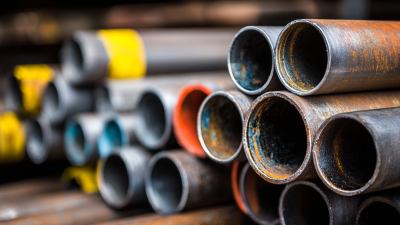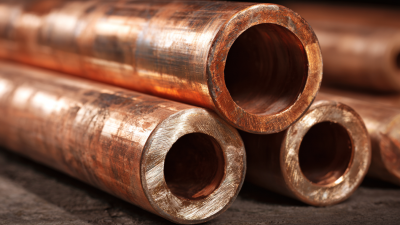How to Choose the Right Pipe Flange for Your Project Needs
In the world of industrial piping, the selection of the appropriate pipe flange is crucial to ensure reliability, safety, and efficiency in various applications.
According to a report by Grand View Research, the global flange market is projected to reach USD 24.68 billion by 2025, emphasizing the growing importance of this component in piping systems.
With a diverse range of materials, sizes, and pressure ratings available, choosing the right pipe flange can be a daunting task for engineers and project managers alike.
Understanding the specific requirements of your project, such as temperature, pressure, and corrosion resistance, is essential to making an informed decision.
This guide aims to equip you with vital considerations and best practices for selecting the ideal pipe flange, ensuring that your project can meet operational needs while adhering to
industry standards and safety regulations.
Understanding Different Types of Pipe Flanges for Various Applications
When selecting the right pipe flange for your specific project needs, it is essential to understand the different types available and their applications. Flanges are critical components in piping systems, providing a means of connecting pipe segments, valves, and other equipment. The most common types of flanges include weld neck, slip-on, blind, and lap joint flanges, each serving unique operational requirements. The choice of flange will depend on various factors, including the material used, pressure and temperature ratings, and the specific application environment.
The global piping and fittings market is currently experiencing robust growth, driven by innovations in advanced construction materials and the push for sustainable solutions. This is evident as the North American copper tubes market is projected to grow significantly from USD 3.18 billion in 2024 to USD 3.44 billion by 2030, correlating with the increased demand for high-performance piping solutions. Additionally, the expanding global compressed air pipes and fittings market, expected to rise from USD 3.43 billion in 2024 to USD 5.50 billion by 2033, further highlights the evolving dynamics in piping applications, emphasizing the importance of selecting the right flanges in order to achieve optimal system efficiency and reliability.
Key Factors to Consider When Selecting Pipe Flanges for Your Project
When selecting the right pipe flange for your project, there are several key factors to consider that can significantly impact the effectiveness and safety of your piping system. First, you should evaluate the material compatibility of the flange with the substances that will flow through the pipes. According to a 2022 report by the American Society of Mechanical Engineers (ASME), approximately 60% of flange failures are due to inappropriate material choices, highlighting the importance of corrosion resistance and mechanical integrity under varying temperatures and pressures.
Another critical factor is the pressure rating of the flange. Selecting a flange with the proper pressure rating ensures it can withstand the operational conditions without leaking or failing. The International Organization for Standardization (ISO) specifies various pressure classes, such as Class 150 or Class 300, which indicate the maximum pressure the flange can support at ambient temperatures. As reported in the 2022 Industrial Piping Standards Review, flanges that are improperly rated for their application can lead to catastrophic failures, costing plants up to $1 million in repairs and downtime. Thus, careful assessment of both material and pressure ratings is essential to ensure the longevity and reliability of your piping systems.

Material Compatibility: How to Choose the Right Flange Material
When selecting the right flange material for your project, it is crucial to ensure material compatibility to avoid adverse reactions that can compromise the integrity of your construction. According to recent findings from industry reports, mismatched materials can lead to issues such as corrosion, failure in joint integrity, and ultimately, costly repairs. For example, when metal flanges are paired with certain plastics, the differences in thermal expansion might lead to leaks over time, especially in high-temperature applications.
Engineers and designers should consider factors such as chemical resistance, temperature tolerance, and environmental impacts when choosing flange materials.

Research shows that PVC flanges are ideal for low-pressure applications involving water, while steel flanges are favored in high-pressure gas lines due to their superior strength. Additionally, a survey highlighting the preferences of construction professionals found that over 60% prioritize material compatibility as a key factor in their purchasing decisions, underlining the importance of pre-project material analysis.
Always refer to compatibility charts and consult specifications from manufacturers to ensure that the materials you choose will work harmoniously together, thus enhancing the durability and reliability of your project.
Sizing and Pressure Rating: Matching Flanges to Your Pipeline Requirements
When selecting the right pipe flange, it’s essential to focus on two critical factors:
sizing and
pressure rating. The size of the flange must match the diameter of the pipeline, ensuring seamless integration into your system. A mismatch can lead to leaks or other failures, jeopardizing both safety and efficiency. Common flange sizes vary, so it’s vital to measure your pipes accurately to choose flanges that provide a tight fit.
Pressure rating is equally important when determining the suitable flanges for your project. Flanges come with various pressure ratings, indicating the maximum allowable pressure for optimal performance. Always consider the operating conditions of your pipeline, as well as any potential pressure surges that may occur.
Choosing a flange with a higher pressure rating can offer extra safety and longevity, particularly for high-stress applications.
Tips: Always consult with manufacturers for detailed specifications and compliance with industry standards to avoid incorrect installations. Additionally, consider the material of the flanges, as it must withstand the environment and fluids transported through the pipeline to ensure durability and reliability.
Installation and Maintenance Tips for Optimal Flange Performance
When it comes to ensuring optimal flange performance, installation and maintenance play critical roles. Proper alignment during installation is essential; misalignment can lead to excessive stress on the flange, resulting in potential leakage or failure. According to a report by the American Society of Mechanical Engineers (ASME), up to 30% of leaks in piping systems are attributed to installation errors. Therefore, using alignment tools, such as laser alignment systems, can significantly enhance the accuracy of flange positioning, thus mitigating risks and extending the lifespan of the connection.
Regular maintenance checks are equally vital. The same ASME report indicates that regular inspections can reduce the likelihood of failures by up to 50%. Maintaining the integrity of seals and gaskets, along with regularly tightening bolts to the manufacturer’s specifications, can help prevent common issues associated with flange connections. Furthermore, employing appropriate cleaning materials and techniques during maintenance guarantees that contaminants do not compromise the sealing surfaces, enhancing reliability and performance over time. Adopting these practices can lead to significantly improved operational efficiency and safety in piping systems.
How to Choose the Right Pipe Flange for Your Project Needs - Installation and Maintenance Tips for Optimal Flange Performance
| Flange Type |
Material |
Pressure Rating |
Temperature Range |
Common Applications |
| Weld Neck |
Carbon Steel |
150 to 2500 psi |
-50°F to 1000°F |
Pipelines, Pressure Vessels |
| Slip-On |
Stainless Steel |
150 to 600 psi |
-50°F to 800°F |
Water, Oil, Chemical Transfer |
| Blind |
Ductile Iron |
150 to 600 psi |
-20°F to 450°F |
Blocking Off Flow |
| Socket Weld |
Alloy Steel |
1500 to 3000 psi |
-50°F to 1000°F |
High Pressure Applications |
| Threaded |
Bronze |
150 to 300 psi |
-20°F to 200°F |
Low Pressure Gas Line |

Home
About Us
Products
Carbon & Carbon Alloy Steel
Stainless Steel
Copper & Nickel Alloy
Heat Efficiency Tubes
Pipe Fittings
Pipe Flanges
Gasket, Stud Bolt &Nut
Industrial Valves
Tech & Service
Blog
Contact Us









